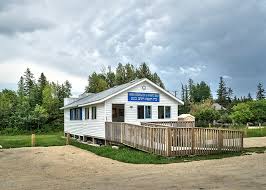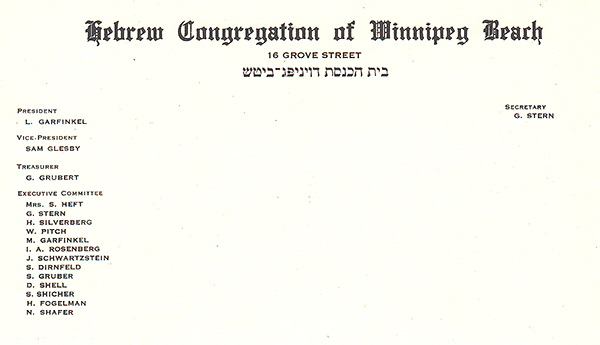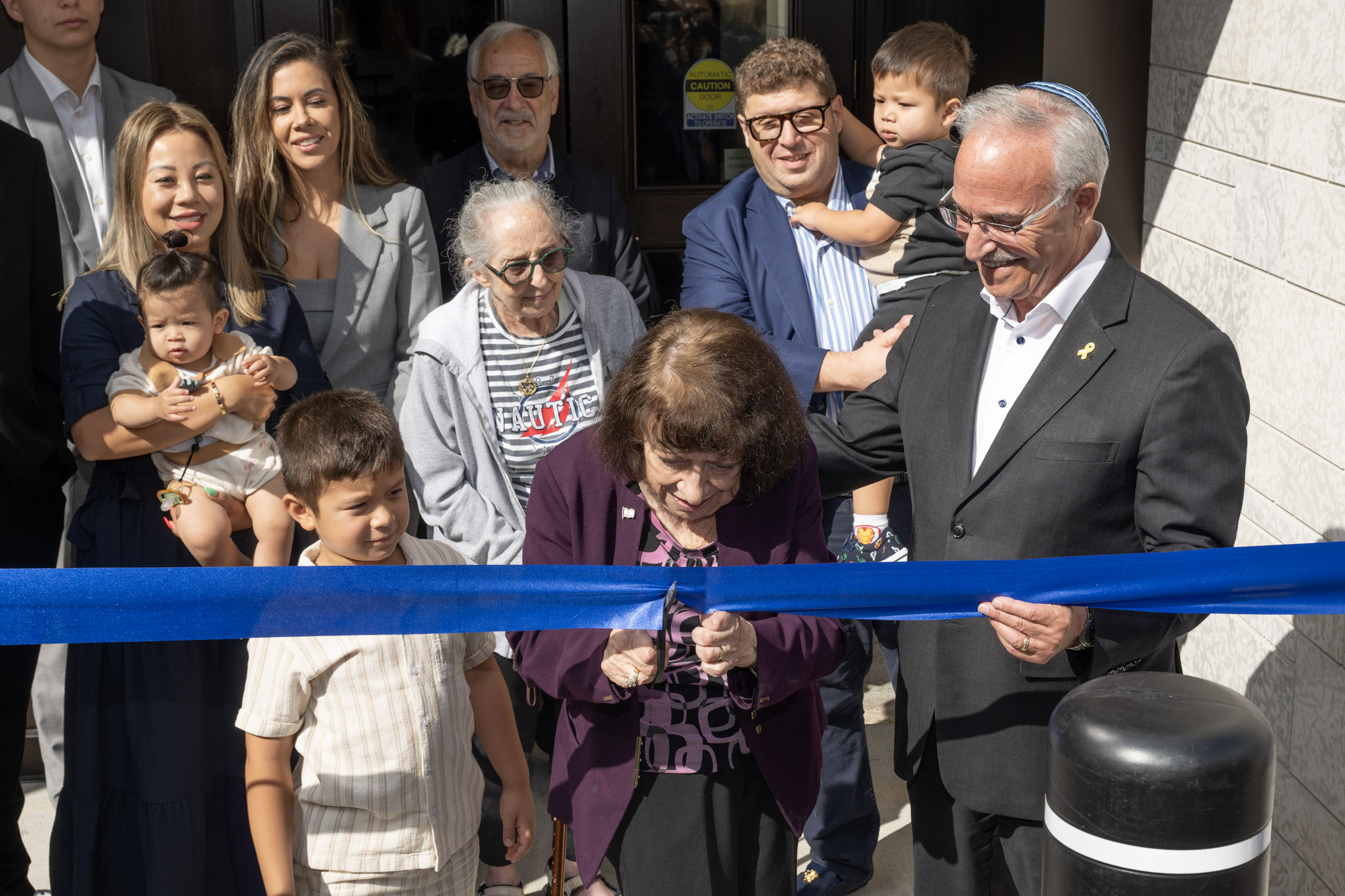Local News
Jewish scholar and bibliophile provides overview of hidden treasures hidden in Chevra Mishnayes congregation library

By MYRON LOVE Most shuls have a library of religious texts – or genizah (storage space) for discards – often books that were either donated specifically to the congregation or private collections dropped off at the synagogue after the original owners passed away.
On Sunday, December 8, the egalitarian Chvera Mishnayes synagogue in Garden City hosted a Lunch and Learning program, the highlight of which was an overview of the books housed at the Chevra Mishnayes – including Chumashim, machzorim, various assorted Talmudic tractates and commentaries on the Torah and Talmud. The program featured a presentation by Justin Jaron Lewis, during which the Yiddishist, bibliophile and professor of religion, revealed subtle features of some of the books, unveiling clues revealing when and where they were published, some direct connections to Winnipeg’s Jewish community and other interesting features.
The Chevra Mishnayes dates back to 1906. It has been at its present location on Jefferson Avenue since 1966. The former Ohel Jacob congregation merged with the Chevra Mishnayes in 1971.
“It’s amazing what people brought with them from the old country,” Lewis commented.
He cited as an example a book from the Chevra Mishnayes collection which was identified as having been bought from a Jewish books store in Toronto, but which had been printed in Poland. He pointed out other books that were published in the 19th century in cities such as Lublin, Vilna and Warsaw – all cities with large Jewish populations.
“The Warsaw edition had Cyrillic writing (based on the Russian-language alphabet) in it,” he noted. ‘Warsaw, Lublin and Vilna were all part of the Russian empire at the time.”
He added that a fourth book was published in Lviv in Ukraine which was part of the Austrian Empire in the 19th Century. “Because the Russians used to tax books that were printed in Russia but were to be taken out of the country, some claimed that their books were published in Austria or another country to avoid the tax,” Lewis explained.
Of interest also, for Jewish geography enthusiasts, Lewis noted, were books with the owners’ names written in them. One book belonged to the family of the well known comedian David Steinberg.
In a second book, Grade 9 Talmud Torah student Israel Pudavick had written his name.
There were other books originally from the collections of a shoichet named B.M Yahweis and one Rev. Martin Weisman.
There are religious commentaries in the Chevra Mishnayes collection penned over the years by Winnipeg rabbis such as Rabbi Y. H. Horowitz, Rabbi Meyer Schwartzman, Rabbi Shmuel Polonsky and one Rabbi Zorach Diskin – who lived in Winnipeg in the early 1900s.
“Some of the books offer a glimpse into Jewish history,” Lewis pointed out. There is one, published in 1865 in Warsaw, which he pointed out, includes a paean to Jewish life in Russia.
Censorship was strict in Russia, he explained. You had to satisfy the censors.
Lewis pointed out that trying to figure out the date of printing for some of the books can be challenging. In some cases, he noted, the book may be a copy – and the copyright date may be the date of the publication of the original. In other cases the date is written in Hebrew letters – leaving researchers to have to translate the letters to their numerical equivalent. What was thought to be the oldest book in the collection, for example, and which was originally estimated to date back to 1819, on further study was determined to be published in 1918.
Lewis also delved into the artwork in some of the books. With the Jewish injunction against recreating human images or those of angels or heavenly bodies, one book in the collection does have a scene where angels are watching as Moses hold the ten commandments and light is streaming from his head.
Another has a scene with Moses and Aaron opposite each other with lions overhead and Roman numerals also in the picture – an example, Lewis suggested of cross cultural influences.
Other popular scenes include the hands of the Cohen doing the priestly blessing The print design and layout can also offer opportunity for artistic flair.
Lewis further note that some of the machzorim have prayers inserrted in Yiddish – for instance, asking for good health – or a good life – or a prayer for one who is ill.
Incidentally, for readers with older Yiddish books at home who are considering trying to find a new home for them, Lewis is one of a handful of Winnipeggers who are collecting Yiddish books for transfer to the Yiddish Book centre in Amherst, Massachusetts.
The book centre,, he reports, is dedicated to finding good homes for such books in university libraries, or the homes of other scholars or other private homes. “A lot of younger people,” he said, “are rediscovering Yiddish and writing songs and poems in Yiddish.”
As to the Chevra Mishnayes’ library, Lewis observed that, as is the case with many other modern shuls, there has not been much interest in more recent years in studying Talmud and Torah.
“Some of the older books are crumbling,” he reported. “Perhaps we should form a committee to cull some of the books that we don’t need and look into ways to better preserve the remainder.
Readers with Yiddish books they no longer want can contact Justin lewis at justin_lewis@umaniotoba.ca
Local News
Thank you to the community from the Chesed Shel Emes

We’re delighted to share a major milestone in our Capital Campaign, “Building on our Tradition.” Launched in November 2018, this campaign aimed to replace our outdated facility with a modern space tailored to our unique needs. Our new building is designed with ritual at its core, featuring ample preparation space, Shomer space, and storage, creating a warm and welcoming environment for our community during times of need.
We’re grateful to the nearly 1,000 generous donors who contributed over $4 million towards our new facility. A $750,000 mortgage will be retired in November 2025, completing this monumental project in just seven years.
We’re also thrilled to announce that our Chesed Shel Emes Endowment Fund has grown tenfold, from $15,000 to $150,000, thanks to you, the Jewish Foundation of Manitoba’s FundMatch program, and Million Dollar Match initiative in 2024. Our fund helps ensure that everyone can have a dignified Jewish funeral regardless of financial need.
As we look to the future, our goal remains to ensure the Chevra Kadisha continues to serve our community for generations to come. Our focus now shifts to replenishing our savings account and growing our JFM Endowment fund.
We’re deeply grateful for your support over the past several years.
It’s our privilege to serve our community with care and compassion.
With sincere appreciation,
Campaign cabinet: Hillel Kravetsky, Gerry Pritchard, Stuart Pudavick,
Jack Solomon, and Rena Boroditsky
Murray S. Greenfield, President
Local News
Winnipeg Beach Synagogue about to celebrate 75th anniversary

By BERNIE BELLAN (July 13) In 1950 a group of cottage owners at Winnipeg Beach took it upon themselves to relocate a one-room schoolhouse that was in the Beausejour area to Winnipeg Beach where it became the beach synagogue at the corner of Hazel and Grove.
There it stayed until 1998 when it was moved to its current location at Camp Massad.
On August 2nd members of the synagogue will be holding a 75th anniversary celebration.

As part of the celebration anyone who is a descendant or relative of any of the original members of the first executive committee (as seen in the photo here) is invited to attend the synagogue that morning.
If you are a relative please contact Abe Borzykowski at wpgbeachshule@shaw.ca or aborzykowski@shaw.ca to let Abe know you might be attending or for more information about the 75th anniversary celebration.
We will soon be publishing a story about the history of the beach synagogue, which is something I’ve been writing about for over 25 years.
Local News
Vickar Family cuts ribbon on new Tova Vickar and Family Childcare Centre

By MYRON LOVE In the words of Larry Vickar, the Shaarey Zedek’s successful Dor V’ Dor Campaign “is not only a renewal of the synagogue but truly a renewal movement of Jewish life in our community.”An integral part of that renewal movement was the creation of a daycare centre within the expanded synagogue. On Monday, June 23, Larry and Tova Vickar cut the ribbon, thereby officially opening the Tova Vickar and Family Childcare Centre in the presence of 100 of their family members, friends and other supporters of the project.
The short program preceding the morning ribbon-cutting began with a continental breakfast followed by a welcome by both Fanny Levy, Shaarey Zedek’s Board President, and Executive Director Dr. Rena Secter Elbaze. In Elbaze’s remarks, she noted that Larry and Tova wanted their family (including son Stephen and family, who flew in from Florida) and friends at the event to celebrate the opening of the Tova Vickar and Family Childcare Centre, “not because of the accolades, but because, as Larry put it, he hopes that their investment in the congregation will inspire others to do the same.”
“When Larry and I spoke about what this gift meant to him and the message he wanted people to take away,” she continued, “I couldn’t help but connect it to the teachings of Reb Zalman Schachter-Shalomi whose book – Age-ing to Sage-ing – changes the whole way we look at the concept of ageing and basing it on our ancestral teachings.”
She explained that his concept of “Sage-ing” is based on three key ideas – Discover your meaning and purpose; accept our mortality and think about the legacy you want to leave.
“Larry spoke about these exact concepts when we met,” she said.
Elbaze also noted the presence of Shaarey Zedek’s newly-arrived senior Rabbi Carnie Rose, former Rabbi Alan Green, and area MLAs Mike Moroz and Carla Compton.
Larry Vickar expressed his great appreciation for all those in attendance. “Tova and I are deeply moved to stand here with you today for this important milestone in our community”, he said. “We are grateful to be surrounded by all of you, the people we care about, our family and friends… you who have touched our lives and played some part in our journey.”
